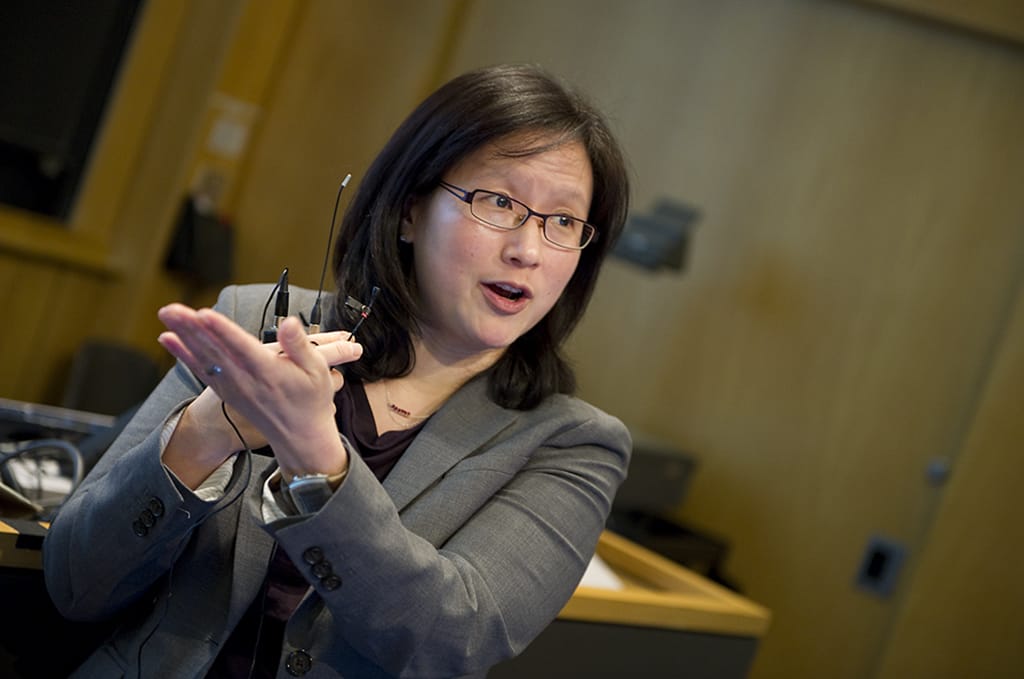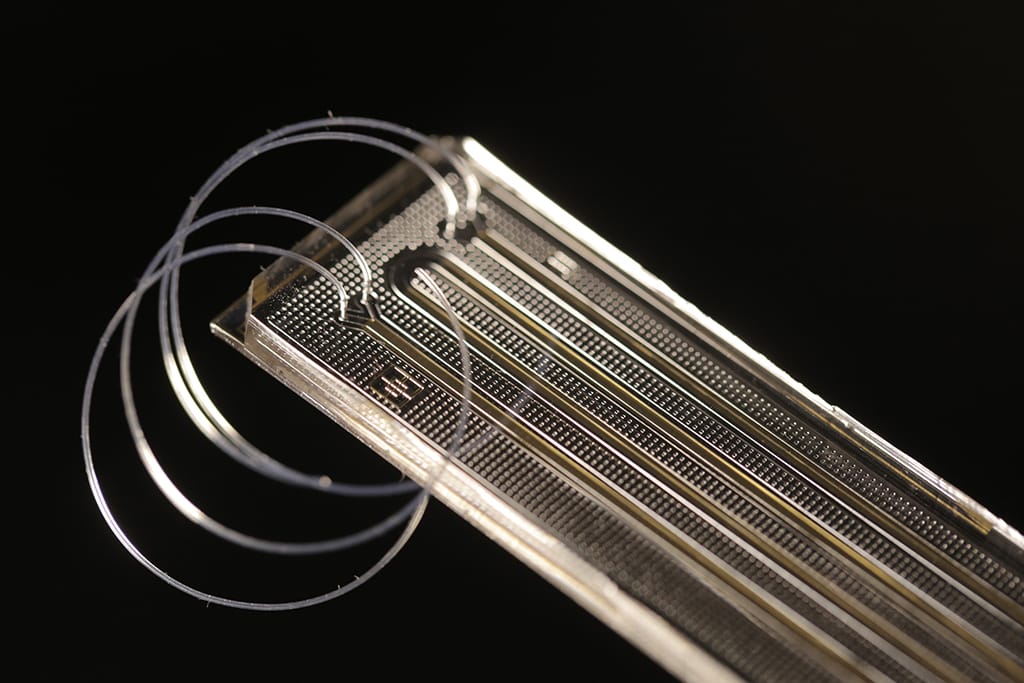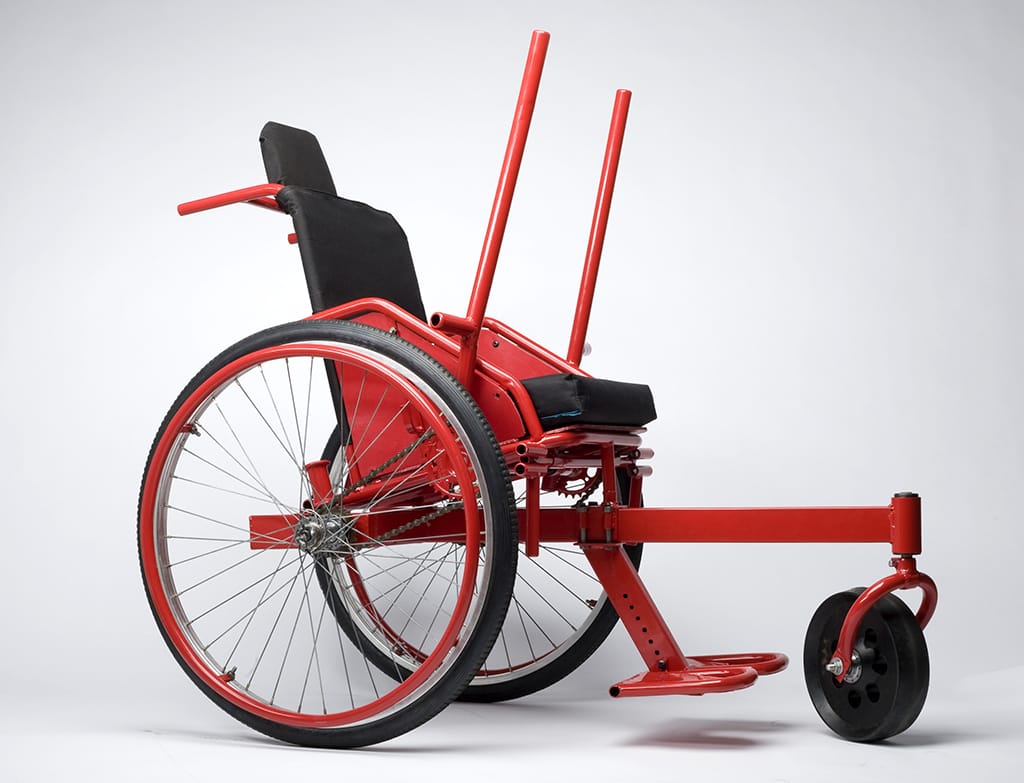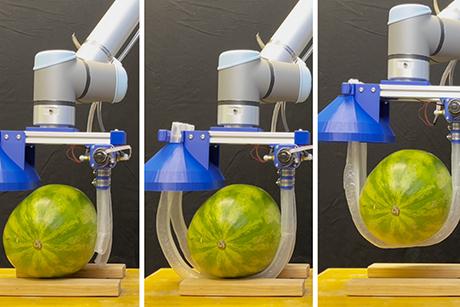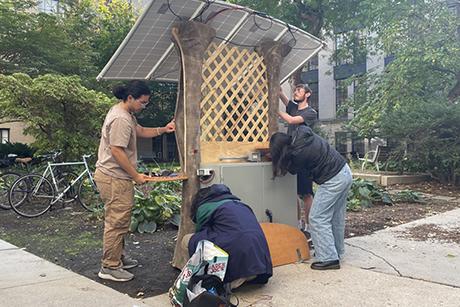The Freedom of Constraint
Engineering for global change.
You’ve probably heard of MechE alum and Associate Professor Hugh Herr (SM ’93), head of the Biomechatronics group at MIT Media Lab.
The TED Talk he gave earlier this year sparked a flurry of media attention when he unveiled his newest bionic limb, BiOM. The power of Herr’s high-tech prosthetic ankle-foot – biomechanics meet microprocessors to emulate a natural gait – became immediately clear when Adrianne Haslet-Davis, a dancer who lost her foot in the 2013 Boston Marathon bombings, danced the rumba across the stage in her first performance since the attack.
It was quite a sight.

Yashraj Narang (SM ’13), an alum of Professor Winter’s GEAR Lab, gets feedback from a prosthetic limb user in India.
Now imagine another amputee, Ashok, who lives and works in India as a farmer. He needs his job just to put food on the table, which, by the way, he has to sit down in front of to eat dinner with his family. Traveling independently on uneven terrain to his field is also a necessity, as is sitting Indian style as he prays.
But earning only about $300 a year, he will need to work for approximately 250 years before he can buy a high-tech prosthetic from the US. He has significantly less money than his rich-world counterparts – yet considerably more urgency.
“More times than not when we look at a technical problem in a developing country, there’s already a solution that exists in the rich world,” says Assistant Professor Amos Winter. “But for a variety of reasons, that solution usually does not map over – it’s either too expensive, not reliable enough, or simply doesn’t solve their particular problems.
“So when you look at these really compelling technical problems in the context of developing countries, there is no known solution.”
Seemingly contradictory emerging market requirements of low cost and high performance make that perfect solution even harder to find.
“When you start looking into the requirements, the technology might have to be 10 or 1,000 times cheaper than what we have in the Western world but still deliver similar levels of performance,” says Professor Winter. “In order to do that, you have to create a disruptive solution completely off the spectrum of what’s currently being done.”

Assistant Professor Amos Winter and GEAR Lab collaborator Pawel Zimoch (SM ’12) meet with farmers in India.
It’s for this reason that Professor Winter enthusiastically embraces the technological constraints he faces in his research projects, placing them at the cornerstone of his lab group’s strategy – not least of which is their signature in-the-field detective work and unusual focus, at least in academia, on bringing their products to market.
This interest in the end goal requires his research group to consider factors that most engineers can skip right over, such as social norms, local politics, in-depth economics, and topographical details, in order to build mechanical solutions that will realistically get put to use. Just like people in rich countries who have lost their legs, Ashok too wants something more than just the quick and obvious. He wants to walk normally, pray normally, sit down to dinner normally with his family. But he can’t afford much comparatively, so while the ideal solution needs to address his complex and nuanced needs, the technology that supports it has to wax simplistic.
“The question that had not been answered yet was how to modify knee torque so it could replicate a normal human gait,” says Professor Winter. “We’ve worked out the theory behind how knee torque should be adjusted with leg mass and how to replicate the ideal torque profiles using only simple mechanical elements that are available and affordable in emerging markets. This research has given us a road map for how to design a high-performance, low-cost prosthetic knee.”
Let’s forget about the solution for a brief moment. How can an engineer – especially one working in a rich country like the US – ever reasonably expect to understand the full extent of Ashok’s prosthetic needs? His circumstances are so different, his needs so ingrained in his social and cultural circumstances, even his methods of communication are perhaps less similar than what we might imagine.
It’s this question of how to design for a user you couldn’t understand from a two-hour focus group that Associate Professor of Mechanical Engineering Maria Yang has started to answer.
“US companies generally think of user-centered design in the context of an industrialized country where you have users that are not that much different than you,” says Professor Yang. “But what if you are dealing with a market that is culturally different, financially different, linguistically different? It really changes the way you design products.
“Good intentions are just not enough,” she adds.
Photo by: Stuart DarschProfessor Yang’s user-centered approach to designing for emerging markets has largely focused on understanding a specific type of user: the microentrepreneur. Along with MechE post-doc Jesse Austin-Breneman (PhD ’14), Professor Yang has researched several case studies of product development for the emerging-market microentrepreneur to identify patterns of success or failure, and her findings were surprisingly contrary to popular belief.
“These microentrepreneurs were willing to make investments in order to generate more income,” she explains, “which flies against the notion that they’re looking for the cheapest option. What they are looking for is a reliable, multifunctional product that often includes unexpected features.”
For example, Professor Yang’s research revealed that a Nokia phone specifically developed for emerging markets was successful in part because it included a multiple-contact-list feature. Figured it out yet? A microentrepreneur would rent his or her one cell phone to several people, each of whom wanted to have their own personal contact lists.

Grad student Jasmine Florentine (SB ’11) speaks with villagers in India to identify the best ways to solicit user needs. Credit: J. Florentine
Ideally, designers could fully integrate themselves into the culture they’re designing for, but that’s not always possible, so another graduate student working with Professor Yang, Jasmine Florentine (SB ’11), began developing a process for identifying user needs in foreign contexts. Her process will determine if these users would realistically use certain products, and if not, identify the barriers to usage. Since this kind of testing often relies on behaviors and conceptions that the users themselves may not even be aware of, it requires some strategic psychology. Florentine presents visual presentations, such as storyboards and physical prototypes, to help cut through social and cultural barriers, and makes thoughtful adjustments to her tone or the wording of the questions to help elicit truthful responses.
“Identifying the problem is half the battle won,” says Associate Professor Rohit Karnik. “I think the most effective solution comes when one is agnostic to one’s own expertise and technologies. That allows engineers to see the problem very objectively, and then to think boundlessly about the best solution.”
For Professor Karnik, the problem was engineering a simple point-of-care device for rapid blood analysis in developing countries. The current process for blood analysis is quite strenuous, starting with the removal of regular cells and time-consuming incubation, then moving on to centrifugation, multiple washings, and finally laser analysis. His solution had to be a smaller, simpler, faster, and less expensive method of collecting the same data these large-scale centrifuges and multi-step processes do today.
“Our thinking process wasn’t constrained by currently technology,” Professor Karnik recalls. “We allowed – even pushed – ourselves to think about solving the problem with technology that isn’t available or even completely understood yet.”
His research team, in collaboration with Professor Jeffrey Karp and others, chose to develop a microfluidic device that engineers cell movement in such a way that the movement itself could reveal important information about a person’s health. The device separates cells by taking advantage of the ways certain molecules bind with other molecules, leaving nature to take its course and allowing the clinician to simply “read” the results. Imagine cells traveling along a path as if they were magnets attracted to a predetermined course.
Photo by: John FreidahProfessor Karnik envisions that this one-step process and handheld microfluidic device would be deployed in developing countries to, for example, use a drop of blood to determine whether or not to give therapy against AIDS, or take a heel-stick drop of blood from a sick infant to determine the status of his or her immune system.
“It’s worth all the effort and risk to try something completely new knowing that if it works it has a good chance of making a significant difference in the world. That potential inspires me,” he says.
If not for the harsh, bare-bone constraints of emerging markets, valuable discoveries, optimizations, and efficiencies might be overlooked.
“In unrestrained environments,” says Professor Ahmed Ghoniem, “you have the luxury of being fascinated by technology for its own sake, and sometimes the technology is all that matters. But in a constrained environment, you have to worry about so many other factors, like can you actually implement the tech where it is most needed? Can you scale it up economically? Is it easy to train locals to use it?”
Professor Ghoniem is developing efficient and cost-effective ways of using clean and alternative energy resources, as well as improving existing energy systems to reduce their environmental impact. One particular method he’s focused on is the use of biomass – biological products such as plants or animal products – as a clean, efficient, and flexible energy source.
In rural India, Professor Ghoniem says, biomass is widely relied upon as an inexpensive energy source for heating, cooking, and even cooling, but in so doing it releases toxic gases and is quite unsafe. It is also a naturally inefficient process: While the biomass is being collected, much of it rots and becomes unusable, and a lot of energy is wasted during the burning process itself.

Graduate student Kevin Kung, a researcher in Professor Ghoniem’s group, during one of his visits to India.
“Biomass in the US is a small fraction of our energy production, but in many places in India, it’s a crucial source of energy,” says Professor Ghoniem. “While it is desirable to expand biomass usage in the US, in India, it’s a life-or-death situation. So we have to do it, we have to do it better, and we have to do it soon.”
It’s this sense of vital urgency that forces innovative solutions out of tight constraints and – thwarting the popular notion that constraints are always detriments – frees engineers from comfortable patterns they can unwittingly become accustomed to. Of course the best solutions rely on knowledge of the complex physics and chemistry, but the implementation must also utilize local resources, be simple to build and operate, and be robust enough to survive and adapt.
Professor Ghoniem’s research group is answering the alarm call, by building a better process for biomass use, one he calls pyrolysis/torrefaction/coalification. During the process, the biomass is improved by pyrolyzing it in an oxygen-deficient environment at low temperature, and the heat that is generated during this process is recycled. It creates briquettes with charcoal-like elements that can burn more cleanly and be stored for long periods of time without rotting, thus making them easier to transport and sell to other communities. His group’s concepts and models are combined with familiarity with the location for fast and effective implementation.
High performance, reliability, multifunctionality, and low cost — what’s not to love? Emerging markets have severe requirements out of necessity, but the significantly optimized results they yield are valuable in every market. Reverse innovation is this practice of translating an optimized product from an emerging market back to developed markets, complete with their significant improvements and cost reductions.
For example, Professor Winter’s Leveraged Freedom Chair (LFC) recently made its US debut after originally being designed for rural developing areas. “When we were developing the LFC for emerging markets, not only did we have to decrease the price point by 10%-40% compared to the standard US cost but we actually had to add performance on top of it,” he says. “We were able to do it, and now we’re bringing this upgraded wheelchair to the US and disrupting the market here as well. The LFC is a truly global product.”
“Real-world problems are human-driven,” adds Professor Ghoniem. “The need for clean energy, for example, is global. Perhaps working on the solution in an environment where the resource constraints force you to find the most efficient or economical solution means that you can also bring back a solution to unconstrained environments that are that much better and more quickly adopted.”
Photo courtesy of GRITIndeed, it does. Professor Winter explains that part of the reason his company GRIT – cofounded along with three MechE alumni: Mario Bollini (SB ’09, SM ’12), Benjamin Judge (SB ’11, MEng ’12), and Tish Scolnik (SB ’10) – decided to develop an upgraded LFC for US and European markets was because of the interest they were receiving from those markets, both from individuals as well as organizations such as the US Department of Veterans Affairs (VA). When GRIT opened a Kickstarter campaign to fund their first run of US-market LFCs, they reached their funding goal within five days.
And the cycle of innovation continues – reverse reverse innovation, as Professor Winter calls it. GRIT is now looking at innovative features from the US-version LFC with an eye toward bringing them back to the emerging market for an ultra-optimized wheelchair that never could exist without the new ideas those market constraints exposed in the first place.
